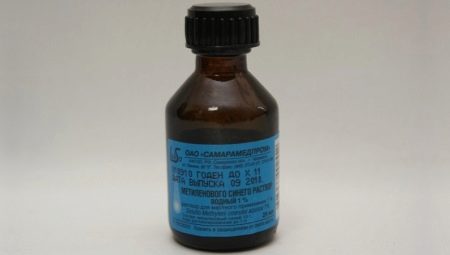For the treatment of fungal bacterial infections in fish, as well as for the disinfection of water in the aquarium, "methylene blue" is often used. This cheap drug becomes a real salvation for an artificial reservoir infected with parasites, bacteria and fungi. The solution, prepared on the basis of "methylene blue", is an effective antiseptic, but if used improperly, it can harm the inhabitants of the aquarium.
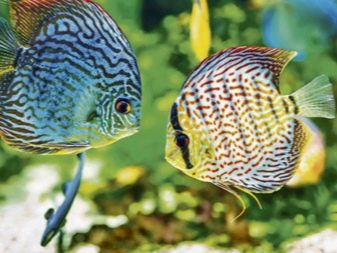

What it is?
"Methylene blue" is a fast-acting antiseptic drug that has a powerful analgesic and redox effect. The main active ingredient of the drug is methylthioninium chloride, an additional component is ethanol. The drug is also known under the trade names blue methylene, as well as methylthioninium chloride.
"Methylene blue" has a disinfecting effect, it is used for emergency and preventive treatment of artificial reservoirs, as well as an air conditioner. This tool is often used to purify water in an aquarium before it is populated by a fish, as well as if parasites were found in the water. Methylene blue is often used as a preventive measure, adding the composition to water in small concentrations.
Aquarists note that this is a highly effective fast-acting drug, it costs literally a penny, in addition, its components do not have a negative effect on the inhabitants of the aquarium. Methylene blue is available in three versions, such as:
- powder;
- crystals;
- solution.

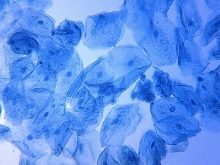
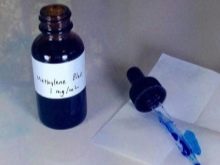
Powders and crystals of methylene blue can be bought at any pharmacy, and the solution is sold only at pet stores. As a rule, it is sold in 50 ml bottles in the form in which it is allowed to be used in fish farming. Store the drug in a dark, dry place at a temperature no more than +25 degrees, placement in the refrigerator and even in the freezer is allowed.
Important! The drug contains a powerful dye, it has a pronounced antiparasitic effect, but at the same time it dyes hands and clothes, so care must be taken when working with it, it is advisable to carry out all the manipulations with rubber gloves.
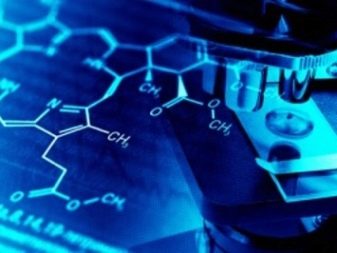
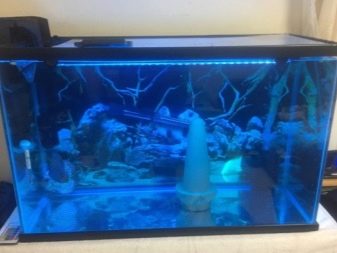
What is it for?
The scope of the use of "methylene blue" in the aquarium is very wide, most often it is used for fungal diseases, as well as for pathologies that are usually caused by unicellular parasites. The drug is effective in the treatment of several diseases.
- Aeromonosis. Among breeders, this disease is more commonly known as carpal rubella or abdominal dropsy. Some time after infection, the fish lose their appetite, they completely stop eating, then they begin to show all the signs of bloating. Over time, the whole body of the fish becomes covered with reddish spots and large bloody smudges. In the treatment of this disease, methylene blue appears as a highly effective agent.
- Branchiomycosis - this is the so-called gill rot. Its first sign is the lethargy of the fish and the appearance of dark red stripes on the gills. If untreated, necrosis of the gill lobes begins rather quickly, in which case they acquire a dirty gray tint.
- Gyrodactyles - A disease caused by parasites - monogenetic flukes of gyrodactylus. Symptoms of the pathology include a quick change in the type of fish and its behavior. The pet becomes stunted, covered with a whitish mucous coating, and hemorrhages are noticeable on the fins.
- Tetrachimenosis - Another rather dangerous parasitic disease. Nevertheless, with proper treatment, it passes quickly, without causing particular harm to the state of health of the fish.
- "Methylene blue" is highly effective in dermatomycosis and branchiomycosis. In addition, the drug is often used to improve the development of eggs and the prevention of fungal infections.
- Blue has proven itself in relieving symptoms of nitrate and nitrite poisoning., as well as in the treatment of blood pathology due to cyanide poisoning.
- Aquarium experts also note that the use of "methylene blue" contributes to the improvement of tissue respiration of fish, the removal of their stress symptoms when moving to a new artificial reservoir. It is known that the drug is often used as one of the active ingredients in the manufacture of antibacterial food.
Important! Fish of all varieties tolerate this drug quite well, so it is allowed to add it not only to water, but also directly to food.
It is convenient in that destroys pathogenic microflora not only in the liquid, but also on the scales of fish, and even in the oral cavity of animals.
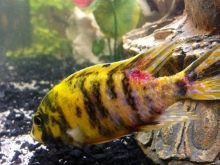
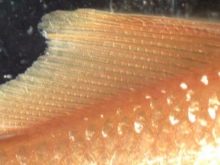
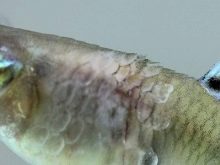
Terms of use
"Methylene blue" gives an exceptionally good result in the fight against all kinds of fungal infections. If you find that growths or mucous secretions appeared on the scales or gills of your pet, you should immediately begin treatment. Methylene blue is very easy to use, even a novice aquarist can understand the instructions for the drug. But an important requirement for the success of treatment will be compliance with the dosage, otherwise, instead of healing, the fish will begin to feel even worse.
To process the aquarium, you must use 20 drops of blue for every 50 liters of water. Keep in mind that you cannot pour the whole solution into water, it must first be dissolved in water in a separate bowl and then infused in small portions. First, the third part of the prepared composition is poured into the tank and carefully mixed. After 30–40 minutes, another third is added, and after half an hour the residues are poured. After five days, half of the aquarium water must be drained and pure (distilled or distilled) added.
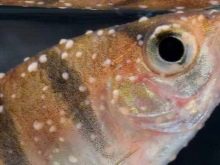
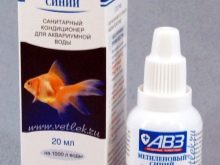
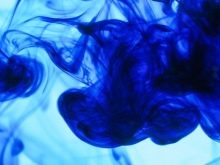
It is very important that the aquarium the compressor worked, creating the necessary aeration - only in this case can the drug be evenly distributed throughout the entire water column. Over time, the dye is removed in the process of water change, as well as filtration.
If several inhabitants of the aquarium are already sick, it is better to treat them in a separate tank. In this case, the dosages are used slightly different: 25 ml of the drug should be dissolved in a bucket of water, in this solution, sick fish should be tolerated about 3.5 hours. Similar manipulations are needed repeat in a day in most cases, the disease goes away after five treatments.
For the treatment of eggs from mycosis and other fungal pathologies, the solution should be less concentrated - usually 1 ml of blue is taken per 50 l of water, eggs should be placed in this mixture for prevention. In case of problems with tissue respiration in aquarium inhabitants, 1 ml of the drug is taken per 75 l of water. In this water, the fish must be kept for about 5 days.
As a preventative measure, “methylene blue” can be added to fish food at the rate of 1 g of the drug per 4 g of food.
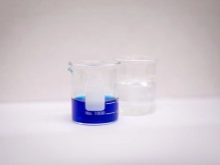
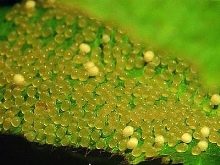
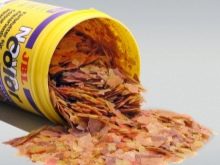
Contraindications and adverse reactions
Despite the fact that methylene blue is characterized by exceptional usefulness and an impressive list of advantages, the product still has its drawbacks and you need to know more about them before you decide to use this drug. Of the minuses of using blue, the following can be noted:
- deterioration of water plants;
- decreased efficiency of the biofilter system;
- staining the walls of the artificial reservoir in blue;
- if the aquarium has light soil - it is painted, too;
- decoration elements installed at the bottom also acquire a pronounced bluish tint.


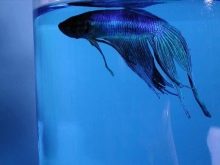
To reduce the risk of adverse effects, treating pets is better in a separate container where a sick pet is made baths. If you carry out general sanitary treatment of the aquarium, then first remove from it all the decor elements that may get dirty, and after a few days it will be useful to clean the entire aquarium.
In the next video you will find more information about the treatment of aquarium fish with methylene blue.
